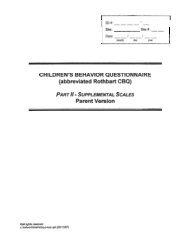A Contextual Investigation of Three-Digit Addition and Subtraction
A Contextual Investigation of Three-Digit Addition and Subtraction
A Contextual Investigation of Three-Digit Addition and Subtraction
You also want an ePaper? Increase the reach of your titles
YUMPU automatically turns print PDFs into web optimized ePapers that Google loves.
144 THE TEACHING AND LEARNING OF ALGORITHMS IN SCHOOL MATHEMATICS<br />
Boxes<br />
Rolls<br />
Pieces<br />
Boxes<br />
Rolls<br />
Pieces<br />
3<br />
2<br />
7<br />
1 4<br />
14<br />
3<br />
+<br />
2<br />
5<br />
8<br />
12<br />
23<br />
Fig. 18.1. The inventory form for the<br />
c<strong>and</strong>y factory<br />
Fig. 18.2. An addition problem<br />
posed on the inventory form<br />
CLASSROOM EPISODES<br />
Throughout the teaching experiment, the students engaged in problem-solving tasks<br />
that focused on transactions in the c<strong>and</strong>y factory. As the sequence progressed, we inferred<br />
that most <strong>of</strong> the students’ activity was grounded in the situation-specific imagery<br />
<strong>of</strong> the c<strong>and</strong>y factory. Our primary source <strong>of</strong> evidence was that the students’ explanations<br />
appeared to have numerical significance in that they spoke <strong>of</strong> the quantities signified<br />
by drawings <strong>and</strong> numerals instead <strong>of</strong> merely specifying how they had manipulated<br />
digits. Further, they <strong>of</strong>ten referred to conventions in the factory such as packing up in<br />
the storeroom. Examples <strong>of</strong> students’ varied yet personally meaningful ways <strong>of</strong> calculating<br />
are shown in figure 18.3.<br />
The nonst<strong>and</strong>ard approach <strong>of</strong> starting the computation with the boxes (the hundreds<br />
column in traditional algorithms) (see, e.g., figs. 18.3a <strong>and</strong> 18.3d) was used by many <strong>of</strong><br />
the students <strong>and</strong> became an acceptable way to solve tasks. Since the goal was not to<br />
ensure that all the students would eventually use the traditional algorithm, the teacher<br />
continued to support the development <strong>of</strong> solutions that could be justified in quantitative<br />
terms to other members <strong>of</strong> the classroom community. Thus, the focus in discussions<br />
was on the numerical meanings that the students’ records on the inventory form had for<br />
them.<br />
Not until the ninth <strong>and</strong> final week <strong>of</strong> the teaching experiment did the issue <strong>of</strong> where<br />
to start when calculating emerge as an explicit topic <strong>of</strong> conversation. The following<br />
problem was posed:<br />
There are five boxes, two rolls, <strong>and</strong> seven pieces in the storeroom. Mr. Strawberry<br />
sends out an order for one box, four rolls, <strong>and</strong> two pieces. What is left<br />
in the storeroom?<br />
Aniquia <strong>of</strong>fered the first solution, shown in figure 18.4. She explained that she first<br />
took two pieces from the seven pieces in the storeroom <strong>and</strong> that she then unpacked a






